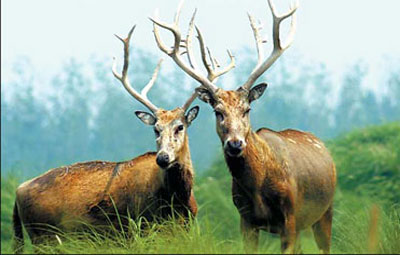As the missionary sent a few Milu to Europe, the species is recorded as Pere David's deer. Even as wars, floods and famine wiped out the country's Milu population in the 1900s, the 11th Duke of Bedford in England gathered 18 Milu from zoos across Europe and raised them on his manor 45 miles north of London.
It was not until 1985 that the Milu finally got a chance to return home. Lord Tavistock, the 14th Duke of Bedford, returned 20 Milu to its homeland as China and Britain inked an agreement to save the species.
The first batch of Milu settled down well at the Nanhaizi Milu Park, the former imperial hunting park in Beijing, and began breeding in 1987. Inspired by this success, Lord Tavistock sent more Milu to China.

Chinese people have regarded Milu deer as a symbol of the carefree life of the immortals for about 2,000 years. (photo: China Daily)
The deer has a strong ability to adapt. Besides Beijing, Milu are also thriving under human care and in the wilderness in the nature reserves at Shishou, Hubei province, and Dafeng, Jiangsu province. Both are located in the lower reaches of the Yangtze River, where Su Shi talked about befriending the Milu.
Ding Yuhua, who has been taking care of the Milu at Dafeng for some 20 years, didn't know what to feed the deer at first. He offered them different kinds of grass and eventually found 198 kinds suitable, many of which had never before been recorded.
In 1987, a pregnant Milu delivered at Dafeng. When the wobbling newborn fell into a nearby ditch, Ding rushed out of his hiding place, dried the fawn with his coat, put it back to its mother and quickly ran away.